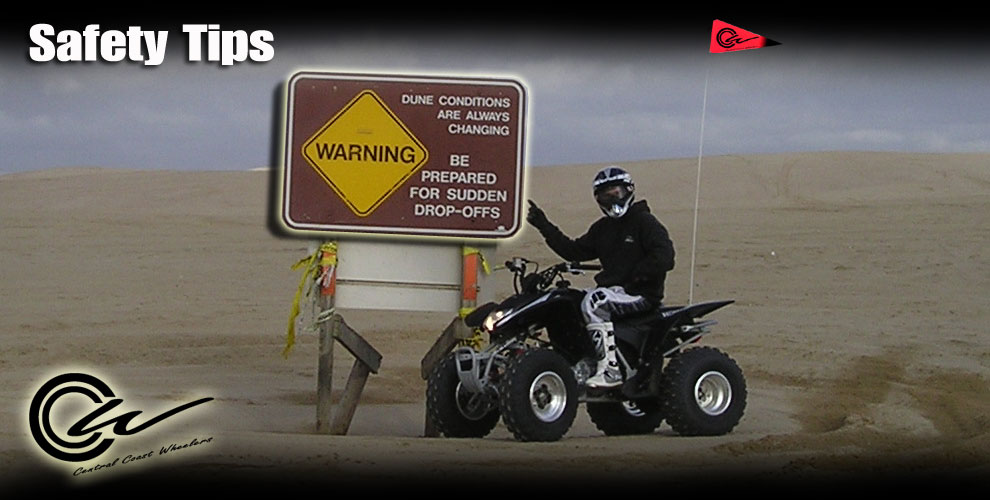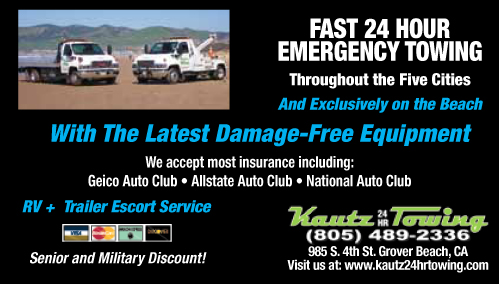| |
 |
|
| |
OCEANO DUNES MOBILE INFORMATION CENTER |
|
| |
|
|
| |
 |
|
| |
-
GO SLOW WHEN YOU ARE GOING INTO THE DUNES!
MOST SERIOUS ACCIDENTS HAPPEN ON THE WAY IN!
|
|
| |
-
It is recommended that all ATV operators take part in a formal safety training course under supervision of a certified ATV instructor. Such training is mandatory for those under 18.
-
Proper riding equipment is essential to the safe operation of an OHV. Each ATV rider must wear a helmet and should wear proper protective clothing.
-
Before starting out, familiarize yourself with the terrain. Learn to recognize the telltale signs of a slipface. AVOID SURPRISES.
-
Inexperienced riders should thoroughly acquaint themselves with all vehicle controls before starting out. Be especially cautious when driving east in the dunes because dune slipfaces normally face to the east.
-
Drive within the limits of your ability. Don’t go faster or climb higher than you can safely handle. Watch out for other riders. When in doubt, take time to think and look the situation over before you proceed.
-
Enjoy your ride with a buddy. Going off into the dunes alone is not recommended.
|
|
| |
TRUCK / DUNE BUGGY TIPS |
|
| |
> |
|
| |
-
Keep your focus on the short term horizons.
-
Drive in arcing right hand turns to become parallel with the short term horizons so you can see into the slipfaces. Some of those will be 100' straight down.
-
Never drive straight up to a horizon. You can not see the conditions ahead which would require you to stop on an uphill or hope for the best (NOT GOOD).
-
Most trucks do not have a problem going slow into a dune straight on. However, Dune Buggies, being lighter, in most cases will high center and sink to the frame.
-
When going up and out a dune, it is best to take the exit on a slight angle so not to high center on the way out.
-
Dune Buggies should use angles both going into and out of a dune.
-
Never hit the brakes or let completely of the throttle when climbing a dune.
-
Bring a tow rope with you. Most rescues in the dunes require 2 ropes.
|
|
| |
If your vehicle becomes stuck, you might try the following: |
|
| |
 |
|
| |
-
Drop your tire pressure, but don't go below 15 lbs PSI.
|
|
| |
-
Dig out the sand from around your tires.
|
|
| |
-
Recruit some friends and — keeping the front wheels straight — push and drive your vehicle either forward or backward. Don't allow your wheels to spin, this will dig you in deeper.
|
|
| |
-
Beach towing is available if needed.
|
|
| |
-
Before you enter the park, find a way to hook a tow strap to your car. If your car does not have safe access towing capabilities, don't drive on the sand! Most new cars have plastic on both the front and back, lower than the actual frame a strap would hook onto. This rips, tears, breaks, scratches, and may even pop the lower panels off trying to tow the car. Look before you get stuck.
|
|
| |
|
|
| |
SWIMMING |
|
| |
Dangerous currents, called riptides, are caused by the combination of wave action and the shape of the shoreline. Should you become caught in a riptide while swimming, don't try to swim against the current. Swim parallel to the shore until you're out of the rip. Then make your way to shore. There is lifeguard service available at Oceano Dunes SVRA June through Labor Day.
|
|
| |
CHECK BACK...MORE TIPS COMING!
|
|
| |
Camping Tips |
|
| |
SHHH....Secret Spots |
|
| |
|
|
| |
|
|
| |
|
|
| |
|
|
| |
|
|
| |
The content on this site are for on-screen viewing only and may not be
copied, reproduced, manipulated or used in any way, for personal or commercial
use, without, the express written permission of CCWHEELERS.com.
©2010 CCWHEELERS.com |
|



